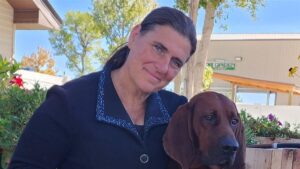
Interview with the Breeder/Owner Handler Jenny Henry
Insights from an Breeder/Owner Handler Jenny Henry. Jenny shares her opinions on various topics about dog handling in the modern show ring.

Home » Dog Breeds » Redbone Coonhound Dog Breed
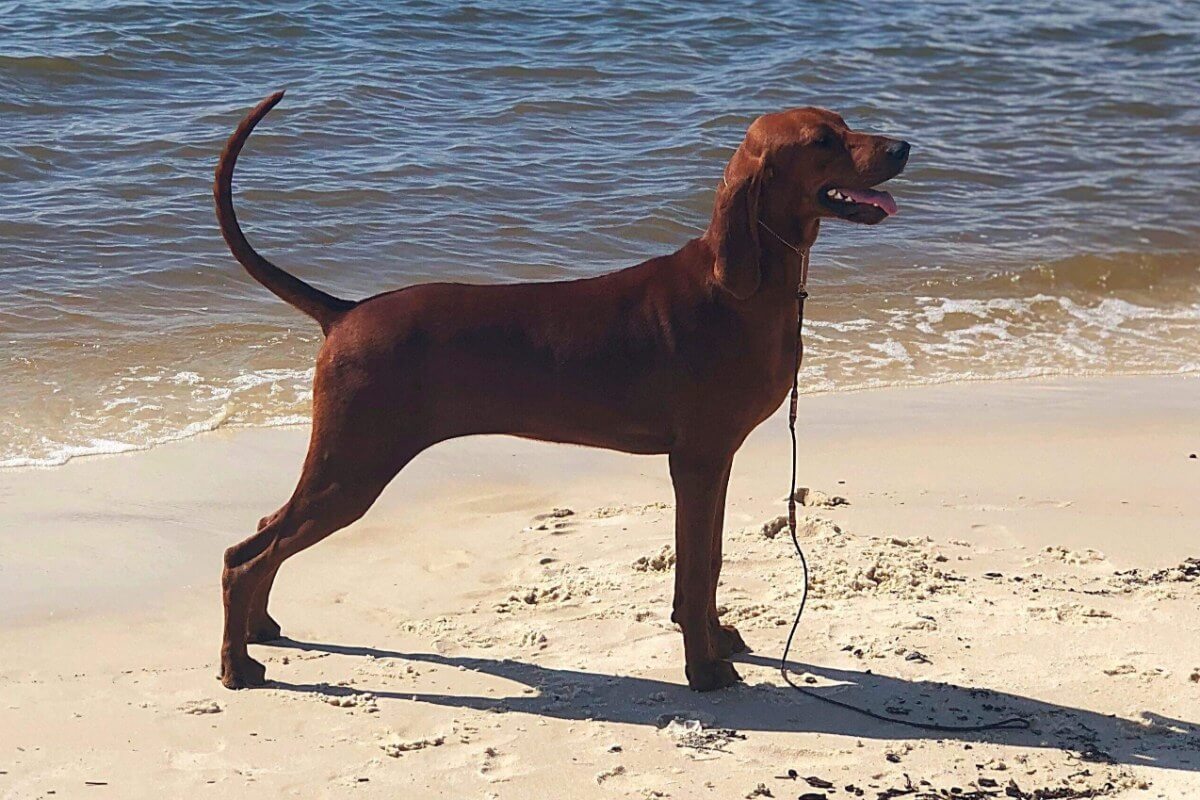
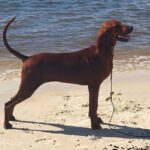
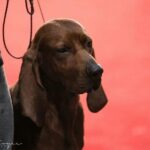
The Redbone Coonhound is a medium-sized scenthound with a magnificent red coat, a pleading expression, and a sweet voice that sings out while on the hunt. Known primarily for its distinctively colored coat, this coonhound is not just handsome, it’s also an intelligent, affectionate, and sensitive companion and an aggressive hunter.
Hound
21 – 27 inches
45 – 70 pounds
12 – 15 years
| Country of Origin | United States |
|---|---|
| Bred For | Small & Large Game Hunting, Companionship |
| Known For | Red Coat, Sweet Voice, Friendliness |
| Popularity | Low |
| Temperament | Even-Tempered, Amiable, Eager to Please |
| Activities | Hunting, Running, Hiking, Swimming, Conformation Shows, Dog Sports |
The history of the Redbone Coonhound is inextricably linked with the emergence of trailing and tracking hounds in the United States. In the late 18th century, coonhounds were specifically bred in the American South for their scenting ability and affinity for treeing the native raccoon. This breed originated through the crossbreeding of Bloodhounds and Foxhounds from Ireland and Scotland.
Redbones were specifically bred to be fast hunters capable of treeing raccoons. The dogs demonstrated agility and unlimited energy, allowing them to cover varied terrain quickly for extended periods. Early on, their distinctive solid red coat, which is a defining feature of the breed today, was intentionally bred.
Redbone Coonhounds have established a reputation as wonderful family dogs due to their loyalty and friendly demeanor, and their versatility lends itself to both home life and field situations. Admirers of the breed value their deep, far-reaching voice, which is especially noticeable when the hounds are on the trail of an attractive scent, much to the neighbors’ chagrin.
The Redbone’s distinguishing trait is its solid red coat, but its persistence on the trail and its loud, melodic bay have secured its place in the hearts and homes of many hunters.
First recognized by the United Kennel Club in 1902, and later by the American Kennel Club in 2009, the Redbone Coonhound is not only respected for its hunting abilities but also for its role as a loyal and loving pet. Due to its tracking abilities and remarkable nose, it has even served in search and rescue operations. The Redbone’s history and its usefulness demonstrate both its legacy as a hunter and its adaptability in contemporary American culture.
Mature male Redbone Coonhounds typically stand between 22 and 27 inches tall at the shoulder, while females usually measure from 21 to 26 inches.
Male Redbones typically weigh between 45-70 pounds, with females weighing slightly less.
The Redbone Coonhound appears as a medium-sized, rather square dog. The breed’s length-to-height ratio is between 5:4 and 10:9. The Redbone’s body is strongly constructed, well-boned, and of good substance, with a weight that is proportional to a hound’s height and bone structure.
Texture: The Redbone Coonhound’s coat is its most notable hallmark. The single coat is short, smooth, and coarse enough to offer protection from the elements. The coat’s texture is as protective as its color is beautiful.
| Standard Color | |
|---|---|
| Red | ee |
A Note About Color: Solid red is the preferred color of the Redbone Coonhound, but a dark muzzle and/or white markings on the brisket and feet are acceptable. White that extends beyond the toes, and white stockings, are not acceptable, nor is white on the brisket that cannot be covered by an open hand. Black hairs may extend around the eyes as a mask, although this is not desirable.
| Standard Marking | |
|---|---|
| White Markings | ee |
The tail of the Redbone Coonhound is a striking feature of the breed, often described as saber-like. Medium in length and strong at its base, with a very slight brush, the tail is set slightly below the level of the backline. The Redbone carries its tail high while hunting, indicating a hound that’s eager to follow a scent trail for hours on end.
The Redbone Coonhound, with its loyal and friendly nature, is a great choice for almost anyone looking to add a kind and caring dog to the household. Sensitive and affectionate, this breed can be a great choice for families with kids, if the hound is properly trained. Redbones, as an intelligent and energetic breed, require a lot of mental stimulation and physical exercise or they can act out by barking and baying out of sheer boredom.
The Redbone Coonhound is generally a healthy breed; however, some can be prone to certain health problems. Hip dysplasia is the most common issue, but that doesn’t mean every dog of the breed will develop it. It’s always important to reduce the risks of disease by acquiring puppies from breeders who health-test their breeding stock.
The average lifespan of the Redbone Coonhound is 12 to 15 years, but with proper care, a balanced diet, and regular wellness exams, many can thrive beyond these years.
Although generally healthy breed, some Redbones may be prone to certain health conditions, including:
The Redbone Coonhound is recognized for being friendly and charming. These hounds are well-known for their friendliness and outgoing personality, which makes them approachable to both humans and other animals. The breed is well-known for its loyalty too, as Redbones create deep connections with their family members and are protective of their loved ones.
Redbones are energetic and playful dogs that enjoy releasing their energy through a variety of activities. While they are brilliant and quick learners, their independence can sometimes manifest as being difficult and intransigent during training sessions.
Teaching the Redbone Coonhound to be obedient can be a challenge if the hound’s owner is not ready to deal with the breed’s independence and occasional stubbornness. However, patience is key and positive training methods, with high-value reinforcement, can help this independent dog to become its “best self” in the home.
This breed thrives on social contact and prefers to participate in family activities. This makes the Redbone less suitable for an environment where a dog is expected to sit on the sidelines. It’s essential to remember that these affable hounds are pack animals that thrive in the company of their human and canine families.
The Redbone Coonhound is also recognized for its somewhat unusual and melodious voice, which, though useful during the hunt, isn’t usually appreciated in suburban settings. These hounds will try their best to communicate with their owners and are likely to bark and bay at everything.
Feeding a Redbone Coonhound requires knowledge of the hound’s specific nutritional requirements and energy levels. As an agile and athletic breed, this coonhound’s feeding requirements may differ somewhat from those of other dogs their size.
The Redbone should do well on a high-quality dog food, whether commercially manufactured or prepared at home under the supervision of your a veterinarian. This breed requires a well-balanced diet that includes a balance of proteins, carbohydrates, and healthy fats.
Redbones will eat eat as long as there is food in front of them. So, it’s important to always measure the daily intake of food and avoid feeding human meals from the table as much as possible.
When it comes to portion sizes, this coonhound typically needs around 2.5 cups of food daily. The best way to feed is to divide the quantity into two to three meals per day, depending on the dog’s needs.
Since the Redbone Coonhound is known to be a passionate eater that’s prone to overeating, it’s important to keep an eye on any weight gain. Obesity has been shown to reduce a dog’s lifespan and increase the risk of several weight-related health problems.
It can be a challenge to begin basic dog training with a Redbone Coonhound. These dogs often like to make their own decisions and go after what they want, whenever they want. As hunting hounds with an independent streak, they will demand a bit more patience from their handlers.
Training Redbones for hunting duties is the easy part of the training. When it comes to other mundane commands, however, this is where problems can begin. Since “sit,” “stay,” and “come” don’t click naturally in their minds, they are known to creatively interpret orders rather than following them to the letter.
Because of the breed’s strong will, punishing a Redbone is not effective. Punishment used in during training sessions can cause even more stubbornness and even resentment and aggression. Positive reinforcement should always be used to reward good behavior. It’s important to remember that hounds typically enjoy both physical attention and treats as rewards for good conduct.
It is extremely important to start training the Redbone as a puppy. Training these dogs as adults requires more effort and patience. Training an adult hunting dog that has already developed certain habits and behaviors means both the hound and the handler have more work to do.
A Redbone Coonhound has excellent hearing and responds well to clear, single sounds. This type of vocal signal is great for a Coonhound because these dogs will adopt “selective” hearing when they’ve treed their quarry and when they’re focusing on something interesting in the yard. Clicker training can be used in short bursts to encourage longer attention spans.
The Redbone Coonhound is known for its intelligence, and as a medium-sized canine, its energy level is just like that – moderate. However, this breed still enjoys plenty of activity, so it’s recommended to provide between one and two hours of daily exercise; the more the better.
| Energy Level | Moderate |
|---|---|
| Exercise Requirements | 1 Hour/Day (Minimum), Daily Walks, Vigorous Running, Regular Exercise, Occasional Swimming, Playing with Another Dog, Mental Stimulation |
Daily walks and runs are essential for releasing the Redbone Coonhound’s energy. Without this form of exercise, this dog may develop behavioral problems such as digging or even barking loudly and enthusiastically.
The Redbone is a real hunting dog that possesses a powerful nose. It will always want to follow any scent trail if it can. Therefore, this coonhound should never be allowed off-leash in a public place where its instinct to chase can be triggered.
The exercise needs of this hound are not limited to physical workouts. The Redbone is an intelligent canine and loves a good challenge. Games that test the dog’s intelligence, such as puzzle toys and games of hide-and-seek, can be as enjoyable for them as an run in the park.
Overall, any kind of exercise is good for a Redbone Coonhound. It can be anything from walking, running, or hiking. Even swimming provides a fun and rewarding experience. As long as sessions are long enough and the dog returns home happy and relaxed, the type of exercise doesn’t really matter.
The Redbone Coonhound is known for a deep red coat that is short, smooth, and coarse enough to be protective. Redbones don’t shed a lot, so maintaining the coat is relatively easy.
| Coat Type | Short, Smooth, Coarse |
|---|---|
| Grooming Requirements | Weekly Brushing, Occasional Bathing, Periodic Nail Trimming, Regular Tooth Brushing |
Brushing teeth should be done weekly with a rubber brush or a glove. This regimen helps to stimulate hair growth and it removes the dead hair that would otherwise find its way onto clothing and upholstery.
The Redbone, as any other smooth-haired dog, should be bathed once every three months. Other than that, bathing should only be necessary should the hound get muddy or if it rolls around in something “fragrant. It’s important to be sure to use lukewarm water and avoid getting shampoo in the eyes and ear canals.
Other maintenance tasks, aside from coat care, include regular ear cleaning to remove any grime and debris. Tooth care is also essential, with frequent brushing or dental chews given to avoid tartar buildup and gum disease.
The Redbone Coonhound’s nails, if not naturally worn down through activity, will need periodic trimming. It’s essential to ensure they aren’t too long, as overly long nails can lead to discomfort and even risk injury to the nails or toes.
The Redbone Coonhound is sensitive, affectionate, and friendly, everything a true dog person can want in a companion. These handsome hounds can be a great addition to active families and individuals who can commit to their care but don’t want a lot of fuss. Barking, it should be known, might be the breed’s only weakness.
Redbones are adaptive to new surroundings, but they can be apprehensive of strangers at first. These hounds typically get along well with children and like playing with other dogs when given the opportunity. However, it is important to supervise them around kids as they make for powerful playmates.
The breed’s coat, as smooth and short as it is, doesn’t offer the Redbone extreme protection in all weather. In colder climates, Redbones might require a doggy sweater or jacket to keep them warm during outdoor activities. Conversely, in hot weather, it’s imperative to protect them from direct sun exposure for prolonged periods and ensure they have ample fresh water always available.
Because of the breed’s affectionate side, the Redbone enjoys spending time with the family, so leaving them alone for extended periods is not a good idea. If left alone at home for too long, they can develop separation anxiety and even become destructive.
The Redbone Coonhound is usually quite vocal; they tend to enjoy the sound of their own voice. Although it is preferable to avoid keeping this breed in an apartment, providing enough outdoor time for running around and plenty of mental stimulation will assist in lessening the Redbone’s need to sing.
From an early age, Redbone Coonhound puppies are energetic and full of energy. Their curiosity, along with a natural desire for chasing and playing, can make them more difficult to settle down; however, if properly trained and socialized, they can be excellent companions in many households.
Before bringing a Redbone Coonhound puppy home, it’s best to make sure the setting is safe. Because the Redbone pup is incredibly active from a young age, regular supervision is required to keep the young one safe. Puppy puzzles and chew toys will keep the puppy busy and can nurture its overall health.
Nutrition is essential during the puppy’s growing phases. To ensure a Redbone puppy gets all the nutrition it needs for good growth and development, it’s important to feed a high-quality puppy formula. A regular feeding schedule is also a good idea during puppyhood and throughout the hound’s life.
Regular veterinary check-ups are crucial in the first year of life. Vaccinations, deworming, and basic wellness exams should be scheduled to ensure the puppy is growing normally.
Important aspects of care for the Redbone Coonhound puppy are basic training and socialization. Training the pup from an early age will encourage good behavior as an adult, while regular exposure to new people, places, and opportunities will instill confidence and reduce the chances of fear or aggression later in life.
With its dynamic energy and strong senses, the Redbone Coonhound is an ideal companion for a wide range of dog sports. Engaging one of these hounds in these activities will not only allow the Redbone to express its natural talents, it will also enhance the link between hound and handler.
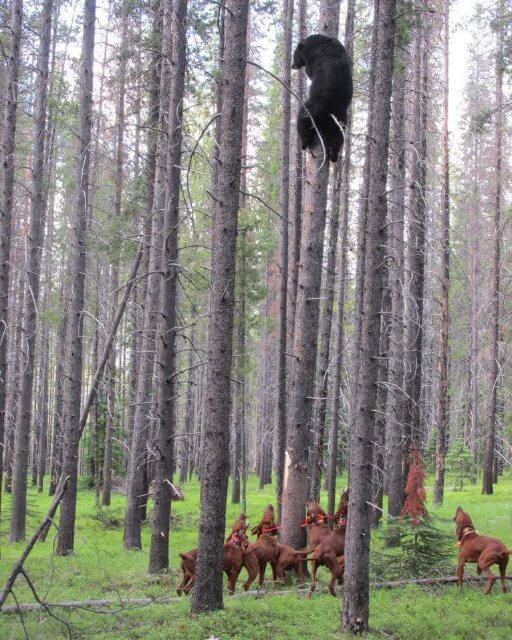
The Redbone Coonhound is recognized by the world’s leading registries and kennel organizations, which categorize the breed into a specific Group based on its unique characteristics. This breed is recognized worldwide under the following Group designations:
| Organization | Group Designation |
|---|---|
| AKC (American Kennel Club) | Hound |
| UKC (United Kennel Club) | Scenthound |
| CKC (Canadian Kennel Club) | Not Recognized |
| ANKC (Australian National Kennel Council) | Not Recognized |
| RKC (The Royal Kennel Club) | Not Recognized |
| FCI (Fédération Cynologique Internationale) | Not Recognized |
The ideal Redbone Coonhound is described by a Breed Standard that is approved by each of the world’s leading registries and kennel organizations. The Breed Standards for this breed may be found in the following links:
| Organization | Breed Standard |
|---|---|
| American Kennel Club | AKC Redbone Coonhound Breed Standard |
| United Kennel Club | UKC Redbone Coonhound Breed Standard |
| Canadian Kennel Club | Not Recognized |
| Australian National Kennel Council | Not Recognized |
| The Royal Kennel Club | Not Recognized |
| Fédération Cynologique Internationale | Not Recognized |
Redbone Coonhound clubs are indispensable in preserving the breed, upholding the Breed Standard, promoting responsible breeding practices, and fostering a community of breeders and breed supporters. These organizations often serve as hubs for education, social and competitive events, and advocacy for the Redbone as a distinct breed.
The National Redbone Coonhound Club (NRCC) operates in the United States and is dedicated to promoting the Redbone through education and events that welcome those who are interested in the breed. The NRCC is the official parent club for the breed with the American Kennel Club.
Joining or engaging with these and similar clubs provides Redbone Coonhound enthusiasts with a wealth of knowledge and opportunities to connect with others who share the same passion for this American breed.
When purchased without previous understanding of the breed’s unique qualities, some Redbones can end up in need of adoption or fostering.
In the US, Tennessee Redbone Coonhound Rescue Group is one of the most dependable rescue organizations. The group’s volunteer members are dedicated to rescuing, rehabilitating, and finding new homes for Redbones throughout the country. Additionally, Coonhound & Foxhound Companions does a great job with rescuing Redbones and other hounds in need. The group’s efforts not only provide relief to hounds in distress, they also offer potential adopters a warm welcome to join a community of people who share an enduring love for the breed.
Redbone Coonhounds are not typically aggressive, especially towards humans. They tend to be friendly, affectionate, and good-natured. However, like any dog, individual temperament will vary, and proper socialization and training from a young age are essential to ensure each hound is well-behaved.
One of the drawbacks of having a Redbone is the breed’s high energy level, which requires a lot of exercise and stimulation. These hounds can become bored and destructive if not properly engaged. Additionally, their strong hunting instincts can lead them to chase after scents, making a secure fence and leash training crucial.
Yes, Redbones shed, although their short coat means the shedding is typically moderate. Regular grooming can help to minimize the amount of hair that’s shed and will keep the coat in good condition. However, potential owners should still be prepared for some dog hair around the house.
Redbone Coonhounds generally have a lifespan of around 12 to 15 years. Like all dogs, their lifespan can be influenced by their genetics, diet, exercise, and overall care. Providing a healthy lifestyle and regular veterinary check-ups can contribute to a longer, healthier life.
Redbones are intelligent and eager to please, which can make them responsive to training. However, they also have an independent streak and can be stubborn at times. Consistency, patience, and positive reinforcement are key when training this Coonhound.
Redbones can make excellent family pets. They are known for their gentle and affectionate nature, and they tend to get along well with children. However, their hunting instincts and high energy levels mean they may be better suited to families with older children who can participate in their exercise and training.
No, Redbone Coonhounds are not considered hypoallergenic. They shed moderately and produce dander, both of which can trigger allergies in sensitive individuals. Potential owners with allergies should spend time around the breed before deciding to bring one into their home.
These Coonhounds can be protective of their family and their territory. They have a strong bark, which they will use to alert their owners to any perceived threats. They are generally not aggressive, however, but should be well-socialized to ensure they can distinguish between normal and threatening situations.
Redbones are not considered a rare breed, but they are less commonly found than some other hounds. Their numbers represent a stable population, particularly in the United States where they are used for hunting and as companion animals. However, they are less common in other parts of the world.
Yes, Redbone Coonhounds are intelligent hounds. They have a long history as hunting dogs, requiring them to think independently and solve problems on the fly. This intelligence can make them trainable, but it also means they need mental stimulation to prevent boredom.
Redbones have a loud and distinctive bark, which they use to communicate while hunting and to alert their owners to anything unusual. They can be quite vocal, and training may be required to manage excessive barking. Providing sufficient exercise and mental stimulation can also help to reduce barking.
These Coonhounds are not known to be excessive droolers. However, like all dogs, Redbones will drool to some extent, especially when they are excited or after drinking water. Keeping a cloth handy for quick clean-ups and ensuring they have access to fresh water can help to manage any drooling.

Insights from an Breeder/Owner Handler Jenny Henry. Jenny shares her opinions on various topics about dog handling in the modern show ring.
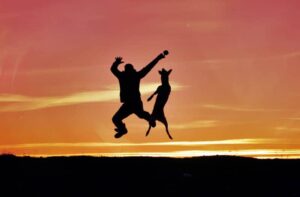
Any good dog parent knows that ALL dogs have the potential to help us stay active. That being said, check out this list of energetic dogs.
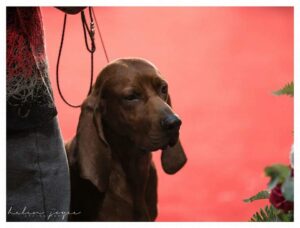
When judging Redbone Coonhounds, I look for the overall dog. I start at the head and work down over the body to the feet, legs, and tail.
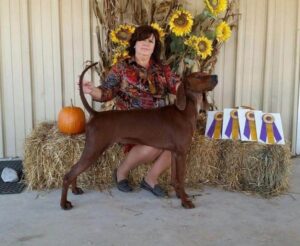
Interview with Hound Group Breeder Lori Mills – My kennel name is Sidearm Kennel. We keep between 40 and 80 dogs, including puppies.
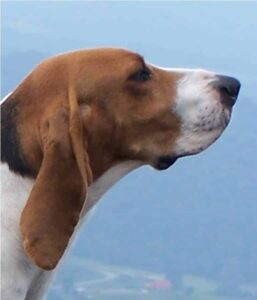
Now that coonhounds are in AKC conformation shows, it is becoming increasingly important that we focus on the correct coonhound structure
The best way to ensure a long and happy relationship with a purebred dog is to purchase one from a responsible breeder. Not sure where to begin?
Contact the National Parent Club’s Breeder Referral Program, which is listed on the AKC Breeder Referral Contacts page.
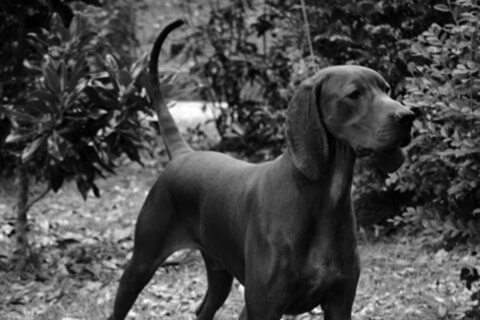

"*" indicates required fields
Showsight Magazine–the world’s most influential purebred dog publication since 1992. Each issue reaches a global audience dedicated to preserving the history and health of purpose bred dogs. Filled with award-winning editorial focused on news and insights from the dog show community, top breeders, handlers, AKC Judges, and more!